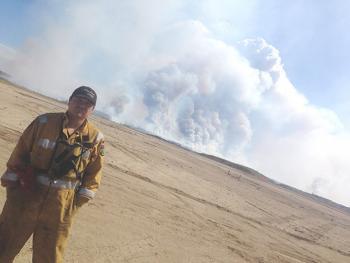Summary
By Shari Narine
Windspeaker.com Contributor
EAST PRAIRIE METIS SETTLEMENT, Alta.
As the wildfires continue to burn in British Columbia, Bruce Cunningham admits a part of him wishes he were on the frontline.
“I feel as if I’m missing out. Once you’re a firefighter you always feel you should be there helping out. It’s not just a job. It’s awesome. It’s like you’re a family out there,” he said.
Cunningham experienced that feeling first hand last year as a member of one of 161 Indigenous firetack crews that fought the fire in the Regional Municipality of Wood Buffalo.
Close to 90,000 people were evacuated from the region, including Fort McMurray. It would take a month before they could return and some neighbourhoods within Fort McMurray remained uninhabitable for months longer.
Cunningham, was on one of two firetack crews from East Prairie Metis Settlement, joined by four other firetack crews in his immediate area – two each from Driftpile First Nation and Gift Lake Metis Settlement – to be called out to Fort McMurray May 1, 2016.
He was there for 18 days. His eight-man crew worked on the frontlines of the fire, beginning each day early and then being called off the line by noon or 1 p.m. when the blaze could only be handled by helicopters and water bombers.
Cunningham says adrenaline was what kicked in when he was fighting the fire and not fear.
“We had flames and they were huge,” he said, but he was never scared because he felt comfortable with the 10-day training he received through Alberta Forestry. He felt that Alberta Forestry’s strategy to fight the Wood Buffalo fire was sound.
And he had faith in the people working around him.
“I knew what to expect and I knew I had my seven other crew members there with me if anything were to go wrong. It’s like a family and you all look out for each other. We had trust,” he said.
Today, he keeps track of the firefight in B.C. through television news and Facebook postings. Because of wet weather and lack of work last fall, Cunningham left the firetack crew to get employment as a Class 1 driver. Presently he’s working on Trans Canada’s natural gas pipeline expansion in Dawson Creek.
There are nine firetack crews from Alberta helping fight fires in BC, which have scorched up to 426,000 hectares so far. Each firetack crew has eight members. The crews come from Fort McMurray, Rocky Mountain House, Grande Prairie, High Level, Lac la Biche and Edson, said Melissa Crawford, community relations specialist with Alberta Agriculture and Forestry.
“In B.C. they’re there right now for sustained action. They are at the direction of whatever B.C. would be asking them to help with. So not necessarily on the front line, not necessarily on clean up, but they could be anywhere,” said Crawford.
Wildland firefighting provides a good opportunity for Indigenous people to get employment, experience, and climb the ladder to such positions as subleader, leader and then sector boss, said Cunningham.
It’s an opportunity that SAAMIS Aboriginal Employment & Training Association, with locations in Medicine Hat and Lethbridge, has embraced.
While Saamis’ first wildland firefighting certification was offered after the Fort McMurray fire, Anita Neefs, executive director for Saamis, says that a follow-up session completed at the end of May 2017 would have resulted in some of those people going to B.C.
“Six of the 12 clients that participated in training were working for wildland firefighter companies. The B.C. fires had not started at that time but these clients would have been the first to be called to the fires,” said Neefs. She’ll know for sure when a second follow-up is held in August.
The Saamis program trains wildland firefighters to work both on the frontline and to cover hot spots.
“It’s a fulfilling job to do. When you’re done, at the end of the day, you know you’ve done your part to help out the community,” said Cunningham. “It makes you feel more fulfilled, as if you did something to help out the world.”

